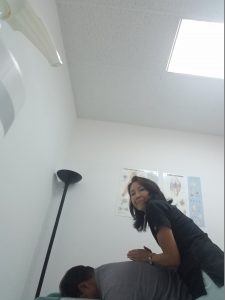From Dr. Natalie Meiri’s Clinical Pearl Stories:
Chiropractic Care For a Frozen Shoulder (Adhesive Capsulitis)
Author: Natalie Meiri, D.C. Posted: 01/07/21
This was a 45 year old patient with a chief complaint of right upper arm pain. To be HIPAA compliant, I will call her Josephine instead of her real name. She was a “snowbird” visiting Florida and had just seen an orthopedist a day ago. She stated the orthopedist recommended drugs (which she didn’t want), physical therapy and/or surgery (which she didn’t want). Josephine came to see me for natural chiropractic care and therapeutic exercises/modalities offered at my office.
During the history, she stated that about 3 months ago, she had right shoulder tendonitis. At that time, she couldn’t sleep due to the pain. Josephine couldn’t recall any specific event that triggered it. Now the pain is much less in her right shoulder. However, her upper arm and especially the biceps brachii muscle (large muscle that lies on the front of the upper arm between the shoulder and the elbow) is very painful.

Josephine’s Examination
Upon examination, Josephine’s loss of shoulder range of motion (movement) was significant. Even with the loss of range of motion, her muscle testing was strong within the available range of motions. Josephine tested positive for a frozen shoulder in all the tests performed.
I explained to Josephine, her biceps brachii muscle hurt from the extra work it was doing. This was due to the loss of normal motion in her shoulder. Moreover, although her upper arm hurt more than her shoulder, the real problem was her frozen shoulder (also called adhesive capsulitis). She then realized that she had been having difficulty with certain activities like putting on her shirt. Josephine couldn’t lift, turn her shoulder or reach like she used to. The upper arm pain was from the unnatural movements to compensate for the lack of shoulder range of motion.
Lastly, I took some shoulder x-rays to rule out any bony blockage possibly due to osteoarthritis (wear and tear type arthritis). The x-rays showed osteoarthritis, but nothing blocking her arm from her range of movements/motion (i.e. bony spur or osteophyte).

Josephine’s Treatments
Josephine’s treatments consisted firstly, of various rhythmic stabilization, “hold-relax” and post isometric relaxation techniques to increase range of motion in her right shoulder. Secondly, muscle stretching and soft tissue therapy, along with exercise, the use of modalities (i.e. moist heat therapy, electric muscle stimulation) and rehabilitation/ home exercises were rendered as necessary. Thirdly, Josephine also had some stiffness in her cervical (neck) and thoracic (mid back) spine. This was from the loss of shoulder abduction (raising your arm out from the sides of your body) and subsequent substitution by shoulder shrugging or trunk leaning. Therefore, chiropractic manipulative therapy (adjustments) was performed to her neck and thoracic spine. Lastly, postural/ergonomic advice and recommendations for activities of daily living (i.e. sleep position to not exacerbate condition) were given.
Josephine regained most of her range of motion back in her right shoulder by her 12th visit and her upper arm no longer hurt. She was able to perform a lot of her activities with ease again. She would continue treatment up north after she left Florida with another chiropractor.
What is a Frozen Shoulder (Adhesive Capsulitis)?
The cause of frozen shoulder/adhesive capsulitis is unknown. It has been associated with diabetes, thyroid disorders, lung disease, trauma, immobilization, and cervical (neck) disk disease. Primarily, thickened shoulder capsular contractures is how it occurs. This capsule is a fibrous sheath (tissue composed of bundles of collagenous white fibers and between are rows of connective tissue cells) which encloses the structures of the joint. Secondary contractures of other areas of the shoulder occur in the following: shoulder ligaments, bursa (sac of fluid that reduces friction between the surfaces of a bone and soft tissue), tendons. Adhesive Capsulitis is more common in 40-65 year olds and is prevalent in sedentary individuals.
The process of developing a frozen shoulder begins as an inflammatory stage/ phase lasting from 2 to 9 months (i.e. similar to acute tendonitis). Next, a stiffening stage lasting 4 to 12 months, where there is a loss of range of motion. Finally, in the thawing stage lasting 6 to 9 months, range of motion is increasing and pain is decreasing.
As in many other conditions, the longer you wait, the more difficult to treat your condition. Josephine presented to my office in the stiffening stage of her frozen shoulder/adhesive capsulitis.
Meiri Chiropractic in West Palm Beach offers a range of body treatments to bring pain relief and healing for a variety of conditions .
Contact us today to learn more about chiropractic care for a frozen shoulder (adhesive capsulitis) or to make an appointment in West Palm Beach.
Meiri Chiropractic
5601 Corporate Way, Ste 102
West Palm Beach, FL 33407
561-253-8984
